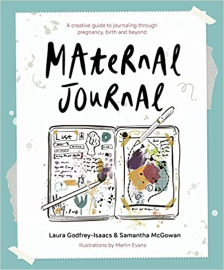AIMS Journal, 2022, Vol 34, No 2
To read or download this Journal in a magazine format on ISSUU, please click here.
|
Maternal Journal: A creative guide to journaling through pregnancy, birth and beyond By Laura Godfrey-Isaacs and Samantha McGowan Illustrations by Merlin Evans Pinter and Martin First edition 2021 ISBN 978178066-745-4 Paperback, 224 pages £16.99 Buy this book on Amazon |
 |
Reviewed for AIMS by Keren Williams
I always thought the term ‘journaling’ was an arty word for ‘keeping a diary’. But after reading the newly published Maternal Journal, I realised it’s whatever you want it to be – poems, lists, painting, sketching, mark-making, collage; the journal offers more than 80 creative ideas to help express thoughts and emotions. What I loved though, is how accessible it is. As a non-artistic person I easily feel intimidated by the pressure to produce something worthy but anybody can access these ideas.
Maternal Journal was produced as part of a project, funded by King’s College, London, to improve maternal mental wellbeing, after research showed that 1 in 4 pregnant women are affected by mental health problems. Many women find that doing something creative on a regular basis can boost self-esteem, reduce feelings of loneliness and isolation, lower levels of stress and anxiety and help defeat depression. So ‘journaling’ is an ideal intervention – it requires very few materials and doesn’t have to be time consuming.
Each ‘task’ in the book is clearly explained by individual artists, poets and writers and full of inspiring examples and illustrations. The directions lead you step by step and even have prompts to help you over the hump of writer’s block or feeling stuck for artistic ideas. It starts with a simple ‘list poem’ – all you need is a pen and some paper and not much time. Ideal for a new mother but also a highly effective way to engage with your thoughts and suppressed feelings. Poet, Holly McNish, urges you to write ‘uncensored’ responses to open questions which help you access the deeper recesses of your mind.
Other suggestions are more colourful, such as Laura Godfrey-Isaacs’ ‘automatic drawing’ session. The idea is to make art, drawing from your subconscious. Laura helps you tap into meaningful memories, thoughts or feelings and transform these into colourful representations; a swirl of lines or shapes, layered with collage or decorative washes or patterns – whatever takes your fancy. She encourages this to be abstract – a free-form response that liberates you from the need to be precise or skilful, rather than a faithful representation..
A more playful option that I loved was Machine Me, by Pia Jaime. She suggests making a collage of magazine images to create a mother machine – a sort of robot that performs all the tasks expected of a mother - cleaner/lover/gardener/therapist, etc,. You will end up with something that looks like a human Swiss Army knife, with a part for every demand. The image left me feeling simultaneously proud and exhausted, which is fairly accurate I suppose.
There are more targeted activities to help address specific problems, such as ‘pain drawings’, where you’re encouraged to create an image of your pain; give it shape and colour and externalise the experience.
As well as being accessible for individuals to use, this book includes some really good resources for anyone wishing to set up a maternal mental wellbeing journaling group. And despite the project’s origin in supporting maternal mental wellbeing, I really think that this book could be used by anybody because the concept is so broad and applicable to any stage of life. I love the quotations from inspiring writers, including Sylvia Plath. Susan Sontag sums up the value of journaling perfectly: ‘In the journal, I do not just express myself more openly than I could to any person; I create myself.’
Author Bio: Keren is a midwife and mother of 22 year old twins.
The AIMS Journal spearheads discussions about change and development in the maternity services..
AIMS Journal articles on the website go back to 1960, offering an important historical record of maternity issues over the past 60 years. Please check the date of the article because the situation that it discusses may have changed since it was published. We are also very aware that the language used in many articles may not be the language that AIMS would use today.
To contact the editors, please email: journal@aims.org.uk
We make the AIMS Journal freely available so that as many people as possible can benefit from the articles. If you found this article interesting please consider supporting us by becoming an AIMS member or making a donation. We are a small charity that accepts no commercial sponsorship, in order to preserve our reputation for providing impartial, evidence-based information. You can make donations at Peoples Fundraising. To become an AIMS member or join our mailing list see Join AIMS
AIMS supports all maternity service users to navigate the system as it exists, and campaigns for a system which truly meets the needs of all.